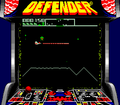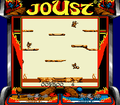Jump to navigation
Jump to search

Box artwork for Arcade Classic No. 4: Defender / Joust.
m (misc. fixes, replaced: ]]( → ]] () |
m (Update guide main page) |
||
| (6 intermediate revisions by 3 users not shown) | |||
| Line 1: | Line 1: | ||
{{Header | {{Header Bar|game=Arcade Classic No. 4: Defender / Joust}} | ||
{{Game | |||
|completion=4 | |||
|image=Arcade Classic No. 4 box.jpg | |||
|title=Arcade Classic No. 4: Defender / Joust | |title=Arcade Classic No. 4: Defender / Joust | ||
|developer=[[Williams]] | |developer=[[Williams]] | ||
|publisher=[[Nintendo]] | |publisher=[[Nintendo]] | ||
| | |year=1995 | ||
|systems={{syslist|gb}} | |||
|ratings={{ESRB|E}} | |ratings={{ESRB|E}} | ||
|title1=Midway Presents: Arcade Hits - Joust / Defender | |||
|developer1=[[Digital Eclipse]] | |||
|publisher1=[[Midway Games]] | |||
|year1=1999 | |||
|systems1={{syslist|gbc}} | |||
|genre=[[Action]], [[Compilation]] | |||
|modes=[[Single player]], [[Multiplayer]] | |||
|preceded by=[[Arcade Classic No. 3: Galaga / Galaxian]] | |preceded by=[[Arcade Classic No. 3: Galaga / Galaxian]] | ||
|series=Arcade Classic | |||
|series2=Defender | |||
|series3=Joust | |||
}} | }} | ||
'''Arcade Classic No. 4: Defender / Joust''' ('''Midway Presents: Arcade Hits - Joust / Defender''' on the Game Boy Color) is a two-game [[compilation]] for the [[Game Boy]]. It contains two classic [[Williams]] games: | '''Arcade Classic No. 4: Defender / Joust''' ('''Midway Presents: Arcade Hits - Joust / Defender''' on the Game Boy Color) is a two-game [[compilation]] for the [[Game Boy]]. It contains two classic [[Williams]] games: | ||
<big> | <big> | ||
* [[Defender]] | * [[Defender]] | ||
* [[Joust]] | * [[Joust]] | ||
</big> | </big> | ||
The games have altered graphics but the gameplay is largely faithful to the originals. The games does not support the Link Cable, but does allow two players to play competitively by taking turns using the same Game Boy. When played on a Super Game Boy the games have borders designed to look like the original arcade cabinets. | The games have altered graphics but the gameplay is largely faithful to the originals. The games does not support the Link Cable, but does allow two players to play competitively by taking turns using the same Game Boy. When played on a Super Game Boy the games have borders designed to look like the original arcade cabinets. | ||
<gallery> | <gallery> | ||
File:Defender SGB.png|Defender | |||
File:Joust GB.png|Joust | |||
</gallery> | </gallery> | ||
{{Arcade Classic}} | |||
{{Defender}} | |||
{{Joust}} | |||
[[Category:Williams]] | [[Category:Williams]] | ||
[[Category:Digital Eclipse]] | |||
[[Category:Nintendo]] | |||
[[Category:Midway Games]] | [[Category:Midway Games]] | ||
[[Category:Action]] | [[Category:Action]] | ||
[[Category:Compilation]] | [[Category:Compilation]] | ||
[[Category:Single player]] | [[Category:Single player]] | ||
[[Category:Multiplayer]] | [[Category:Multiplayer]] | ||
Latest revision as of 19:47, 17 March 2024

| Arcade Classic No. 4: Defender / Joust | |
|---|---|
| Developer(s) | Williams |
| Publisher(s) | Nintendo |
| Year released | 1995 |
| System(s) | Game Boy |
| Preceded by | Arcade Classic No. 3: Galaga / Galaxian |
| Series | Arcade Classic, Defender, Joust |
| Genre(s) | Action, Compilation |
|---|---|
| Modes | Single player, Multiplayer |
| Rating(s) |
| Midway Presents: Arcade Hits - Joust / Defender | |
|---|---|
| Developer(s) | Digital Eclipse |
| Publisher(s) | Midway Games |
| Year released | 1999 |
| System(s) | Game Boy Color |
Arcade Classic No. 4: Defender / Joust (Midway Presents: Arcade Hits - Joust / Defender on the Game Boy Color) is a two-game compilation for the Game Boy. It contains two classic Williams games:
The games have altered graphics but the gameplay is largely faithful to the originals. The games does not support the Link Cable, but does allow two players to play competitively by taking turns using the same Game Boy. When played on a Super Game Boy the games have borders designed to look like the original arcade cabinets.
-
Defender
-
Joust
Arcade Classic series

